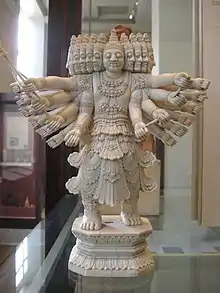Bisrakh
Bisrakh is a village 10 km away of Greater Noida, in the Indian state of Uttar Pradesh.
Bisrakh | |
|---|---|
 Bisrakh | |
| Coordinates: 28.571298°N 77.432116°E |
The locals claim their village to be birthplace of the legendary king Ravana, who rules Lanka in the epic Ramayana. During the Dussehara festival, which celebrates Rama's victory over Ravana, effigies of Ravana are burnt in several parts of India. However, in Bisrakh, the nine days of Navratra ending in Dassehara are observed as a period of mourning when they offer prayers for peace to the soul of Ravana and perform Yagna.[1][2][3] Locals believe that if Ramlila were to be performed in the village, it would trigger the wrath of Ravana on the villagers.
Location
Bisrakh is a small village, in the Gautam Budh Nagar district[4] which adjoins the urban center of Noida, and which still retains an ancient layout consisting of narrow lanes, dirty and potted roads. It is the headquarters of the administrative center of Bishrak Block in western Uttar Pradesh.[5][1][6] It is 30 kilometres (19 mi) away from the national capital, New Delhi.[7]
Legends
According to a local legend, the name of the village is a derivation of Vishravas, father of Ravana, who was a famous sage of the ancient times who lived and worshipped Shiva in this village. Ravana who was born in this village had spent his early childhood here. Vishravas had found a linga in the forest area and had established the Bisrakh Dhaam (abode of God) with the linga deified therein where he offered worship.[5][1]
According to mythology, Vishravas, a Brahmin, had wedded Kaikesi, a rakshasa princess; Ravana thus had a mix of Brahmin and rakshasa (not demon in Indian mythology rakshasa cannot be literally translated to demon) blood. Vishravas's elder son by his first wife was Kubera, now worshipped as a god of wealth, who ruled Lanka until Ravana became the king himself.[5]
According to local belief celebrations of Ramlila in Bisrakh would invite the wrath of Ravana.[8] Instead, fire sacrifices or Yajnas are held during Navratra festival to the Shiva linga praying homage to Ravana.[9]
Temples
Several temples exist in the village that are over 1,000 years old. The Swayambhu (self manifest) Shiva linga, which was worshiped by Ravana and his father Vishravas, was unearthed more than 100 years ago. It is octagonal in shape. The linga is visible above the surface for 2.5 feet (0.76 m) height and a further 8 feet (2.4 m) length is said to extend below the ground. It is deified in a temple here and worshipped daily. The temple is set near a large banyan tree and has a courtyard laid with marble.[5][9]
A new temple dedicated to Ravana is under construction at a cost of Rs 2 crores. This temple will be deified with a 42 feet (13 m) Shiva Linga and a 5.5 feet (1.7 m) image of Ravana.[7]
Demographics
According to 2011 Census, the village has a total population of 5,470 (24.31% consist of Scheduled Caste) population of 882 families; 2,921 are males and 2,549 females with an average sex ratio of 767 much less than the Uttar Pradesh state average of 902. Literacy rate is 77.58% which is higher than the state's figure of 68.01%.[10]
Economy
The economy of the village and the Bishrakh Block was mainly agriculture to the extent of 70% with the balance 30% related on non-agricultural activities of people such as teachers, administrative and police officials, politicians, carpenters, shopkeepers, barbers, and also agricultural labour. The village, compared to the rest of the Block, has non-farmer elitists, and elite farmers who own land area of 40 bighas or more, with the richest farmer owning 300 bighas. However, the economy is still considered "subsistence level." for the village as a whole.[11][12]
References
- "The Indian Express". indianexpress.
- "Hindustan Times".
- "The Times of India".
- "Project Report: Evaluation of Socio- Economic Development in Small Areas" (pdf). Planning Commission. 2004.
- Vasudevan 2013, p. 35.
- Journal of Social and Economic Studies. A.N.S. Institute of Social Studies. 1978. p. 186.
- "Bisrakh seeks funds for Ravan temple Purusharth Aradhak". The Times of India. 4 October 2014.
- Bisrakh-Bleeding Pen
- "Ravana is the son of this soil, believe locals of Noida's Bisrakh village". DNA. 22 July 2014.
- "Bisrakh Jalalpur Population - Gautam Buddha Nagar, Uttar Pradesh". Census2011.
- Vasudevan 2013, p. 92.
- Sachchidananda 1980, p. 160.
Bibliography
- Sachchidananda, Sachchidananda (1980). Elite and Development. Concept Publishing Company. pp. 160–. GGKEY:2QLJ09TPF3U.CS1 maint: ref=harv (link)
- Vasudevan, Vandana (22 November 2013). Urban Villager: Life in an Indian Satellite Town. SAGE Publications. ISBN 978-81-321-1783-4.CS1 maint: ref=harv (link)
